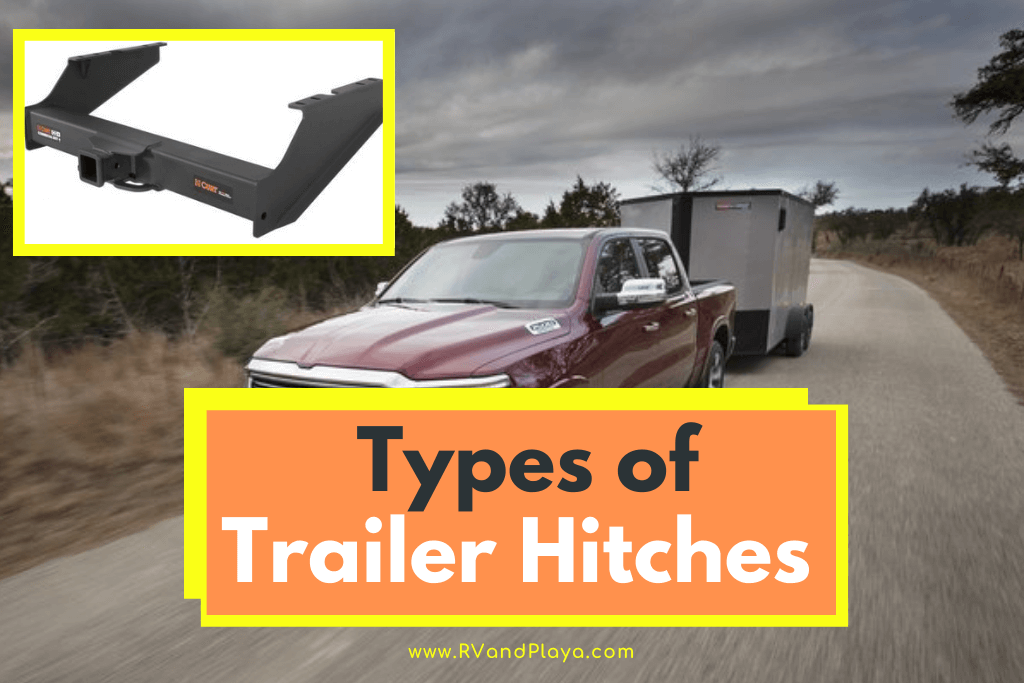Have you ever wondered what are the different types of trailer hitches and hitch classes? Look no more. We´ve got you covered.
Navigating the world of trailer hitches can be rather difficult. There are several different types of hitch available, and each has an ever so slightly different purpose.
On this page, we want to walk you through the various types of trailer hitches and receivers available.
So, what are the different types of trailer hitches? We found 7 common trailer hitch types which include:
1. Rear Receiver Hitch
2. 5th Wheel Hitch
3. Front Mount Hitch
4. Gooseneck Hitch
5. Pintle Hitch
6. Bumper Hitch
7. Weight Distribution Hitch
We are hoping that this guide will go a long way toward helping you to discover the hitch type that is going to be right for you.
Table of Contents
Different Types of Trailer Hitches
As we said, there are a variety of different trailer hitches out there. It is up to you to choose the one that is going to be right for you.
In this section, we want to give you a brief overview of all of the hitch types, plus some of the purposes that you may be able to use them for.
Of course, as with everything, you should do your own research into the individual product that you may have your eye on. This is because weight limits, etc. will differ from trailer hitch to trailer hitch.
Read also: How Much Does It Cost to Install a Trailer Hitch? (with 9 examples)
Rear Receiver Hitch
This is probably the most common type of hitch that you can buy. It is also going to be one of the most versatile hitches on the market.
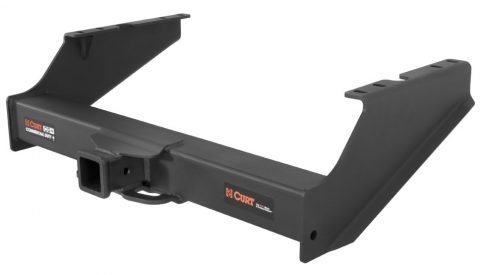
| Hitch Type | Capacity | Function | Availability |
|---|---|---|---|
| Rear Receiver Hitch | Up to 20,000 lbs. | Provides a tube for accessories | Available for most vehicles |
As the name suggests, a rear receiver hitch will connect to the back of your vehicle. On the hitch, you will find a square tube.
The idea of this square tube is that you can fit your own accessories into the hitch receiver e.g. a ball hitch. This means that the rear receiver hitch will allow you to tow a variety of different things using the same installation.
There are a variety of different rear receiver hitch sizes available, and we will talk about those later on. Each of these sizes should give you an idea of the amount of weight that the rear receiver hitch is able to support.
Although, once again, we must stress that this is something that is going to be different from product to product.
You need to make sure that you read through those product reviews and specifications to know what you are going to be getting.
If you want the most general-purpose hitch i.e. you are going to be towing your average trailer, then this is the type of hitch that you want to be going for.
Front Mount Hitch
A front mount hitch is pretty much going to be the reverse option to the rear receiver hitch. This means that you are going to end up with an accessory that connects directly to the front of the vehicle.
There will be a receiver slot where you are able to slide in a variety of accessories.
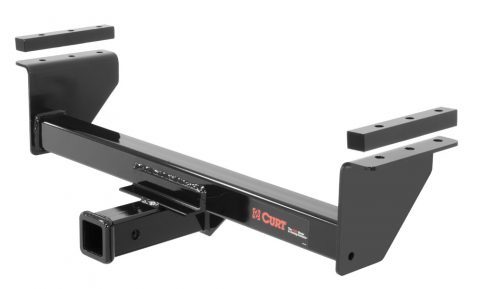
| Hitch Type | Capacity | Function | Availability |
|---|---|---|---|
| Front Mount Hitch | Up to 20,000 lbs. | Provides a tube for accessories | Available for most vehicles |
As you can probably imagine, a front mount hitch isn’t really going to be that versatile. In fact, it is going to be next to useless if you are planning on towing trailers. You can’t really tow something that is in front of you, can you?
These hitches are often used for those that want to attach snow plows and the like to their vehicle. They can also hold spare tires.
If you do a lot of off-roading, then it may actually be worth your time to get a front mount hitch installed. This is because they are going to be absolutely fantastic for installing a winch on them.
Of course, you can easily have a front mount hitch and a rear mount hitch installed without any issues.
However, if you are planning on connecting something up to both hitches at the same time, it is important that you do not go over the weight limit of your vehicle or you are going to be running into all sorts of problems.
5th Wheel Hitch
If you are towing a hefty RV or trailer, then a standard rear mount hitch probably isn’t going to cut it. In fact, it is tough to be able to fit up an RV to your standard hitch. What you need is a 5th Wheel Hitch.
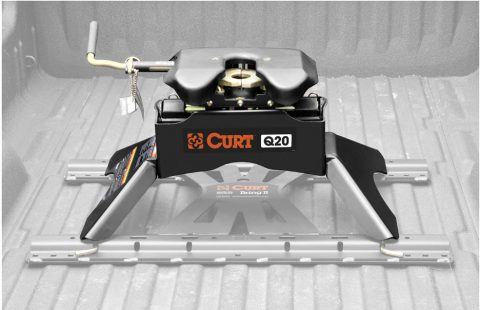
| Hitch Type | Capacity | Function | Availability |
|---|---|---|---|
| 5th wheel Hitch | Up to 30,000 lbs. | Couples to a 5th wheel kingpin | Pickup trucks only |
A 5th Wheel Hitch is designed to be installed in the back of a truck. So, if you do not have a truck, then you won’t be able to install a 5th wheel hitch.
If you do not have a 5th wheel hitch, then you may not be able to tow the RV that you want to be towing.
Read also: How Much Does It Cost To Install A 5th Wheel Hitch Near Me?
These hitches can hold a substantial amount of weight. This is between 24,000lbs and 30,000lbs. Although, this is something that is going to be varying between 5th Wheel Hitches, so do make sure that you check the specifications of the hitch.
So, how do they work? Well, the trailer will have something known as a ‘King Pin’ on it. The King Pin will be moved into a slot on the 5th Wheel Hitch.
The 5th Wheel Hitch will then have some jaws in it which you close, locking the trailer into place.
Gooseneck Hitch
A gooseneck hitch is similar to a 5th wheel hitch in some ways. This is that it fits into the bed of a truck. It can also hold the same amount of weight i.e. up to 30,000lbs.
They take up a lot less vertical space too, and their less bulky size means that you will be able to fit more into your truck bed while you are towing.
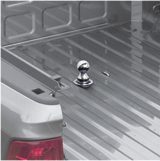
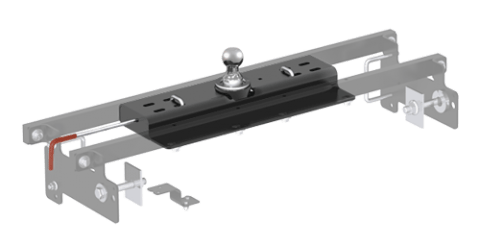
| Hitch Type | Capacity | Function | Availability |
|---|---|---|---|
| Gooseneck Hitch | Up to 38,000 lbs | Couples to a gooseneck trailer | Pickup trucks only |
Although, of course, make sure that you do not go over the weight limit of your vehicle!
A gooseneck hitch is not really something that you need if you are only driving recreational trailers and RVs around.
This is because this type of hitch has, mostly, been designed for use with agricultural vehicles. This means agricultural trailers, livestock movers, etc.
You can think of a gooseneck hitch as being like a vertical ball hitch. It works by sliding the trailer over the ball hitch and then you are ready to hit the road. Once everything has been locked into place, of course.
Pintle Hitch
Pintle hitches are not used that often. However, they do have a surprisingly high weight rating. Some options on the market are able to carry a whopping 60,000lbs.
You can think of a pintle hitch as being like a big hook. The trailer that you are connecting up to a pintle hitch will have an eyelet on it.
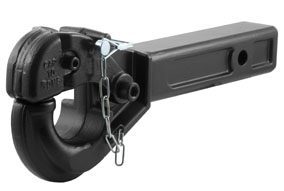
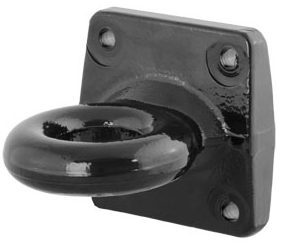
| Hitch Type | Capacity | Function | Availability |
|---|---|---|---|
| Pintle Hitch | Up to 60,000 lbs. | Couples to a lunette ring | Available for heavy-duty vehicles |
This eyelet will then slide onto the pintle hitch hook. This will clasp it tight, allowing you to tow the vehicle.
As we said, a pintle hitch is not all that common nowadays. However, if you have a rear mount hitch receiver, then you will likely be able to find an accessory on the market that you can use to convert it into a pintle hitch if you really want.
Bumper Hitch
Bumper hitches are not for towing anything heavier than a lightweight trailer. You should never, ever use a bumper hitch to pull an RV or horse trailer, for instance.
A bumper hitch is similar to a rear mount hitch as the fact that it has a square hitch receiver on it. You will be able to attach all manner of towing accessories into this square hitch.
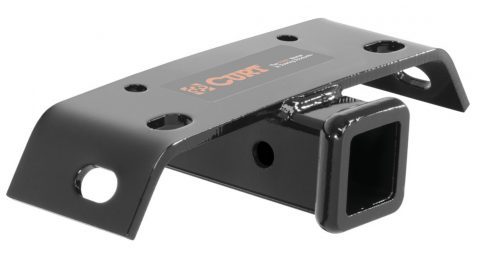
The major downside of a bumper hitch is that it is connected up to the bumper. This does mean that you will be able to install it on a lot more vehicles.
However, because it is connected to the bumper of the vehicle, it cannot tow a huge amount of weight. In fact, the bumper of your vehicle is more likely to be the weak point here than the hitch itself.
Weight Distribution Hitch
A weight distribution hitch isn’t an actual hitch type in itself. Instead, it is an accessory that plugs into a hitch receiver.
If you are planning on towing an RV or any6thing on the heavier side of things, then it is worth knowing about the weight distribution hitch, though.
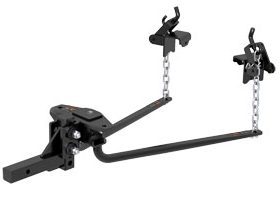
| Hitch Type | Capacity | Function | Availability |
|---|---|---|---|
| Weight Distribution Hitch | Up to 15,000 lbs. | Helps level vehicle and trailer | Requires hitch receiver |
As you may well know, many hitches have a maximum tongue weight on them. The vehicle will also have a maximum tongue weight. As soon as you start to creep close to that maximum tongue weight, the vehicle becomes a lot more difficult to control.
you also run the risk of the bottom of the vehicle becoming damaged as you go over bumps in the road, etc.
The purpose of a weight-distribution hitch is, as the name suggests, to distribute the weight. It will take a bit of weight off of the tongue of the hitch.
This will allow you to tow heavier loads. Even if you do not tow heavier loads, you will often find that it is easier to control your vehicle. This is because you won’t really feel as if you are pulling something incredibly weighty along the road.
How to Select a Trailer Hitch >> Check out the video below:
Different Trailer Hitch Classes
So, what are the different trailer hitch classes? We found 5 common receiver hitches classes, depending on their towing capacity and receiver tube size. The higher the class number, the higher the capacity and the larger the receiver tube is:
- Class 1
- Class 2
- Class 3
- Class 4
- Class 5
The hitch class comparison chart shows the trailer hitch classes and the receiver size:
| Hitch Class | Applications | Receiver Size | GTW Capacity (lbs.) | TW Capacity (lbs.) |
|---|---|---|---|---|
| Class 1 | Cars and crossovers | 1-1/4-inch | Up to 2,000 | Up to 200 |
| Class 2 | Cars, crossovers and minivans | 1-1/4-inch | Up to 3,500 | Up to 350 |
| Class 3 | Crossovers, vans, SUVs and trucks | 2-inch | Up to 8,000 | Up to 800 |
| Class 4 | Trucks and SUVs | 2-inch | Up to 10,000 | Up to 1,000 |
| Class 5 – Xtra Duty | Trucks and SUVs | 2-inch | 16,000 to 17,000 | 2,400 to 2,550 |
| Class 5 – Commercial Duty | Dually and chassis cab trucks | 2-1/2-inch | 18,000 to 20,000 | 2,700 |
5 Trailer Hitch Classes
As we just said, there are five different trailer hitch classes out there. We want to give you a general overview of each of them in this section.
Class 1 Hitches Explained
Class 1 hitches are the smallest hitches that you can purchase. These are designed for light towing, mostly with cars.
They have a 1 1/4″ receiver size, can tow up to 2,000lbs, and have a maximum tongue weight of 200lbs. You will never be able to carry anything more than just a small load with these hitches. They aren’t up to the job.
- Receiver Size: 1-1/4″ x 1-1/4″ receiver
- Weight Rating: Up to 2,000 lbs. GTW
Class 1 vs Class 2 Hitch
Both Class 1 and Class 2 hitches will have a 1 1/4″ receiver size. However, there is a difference in the amount of weight that they are going to be able to pull.
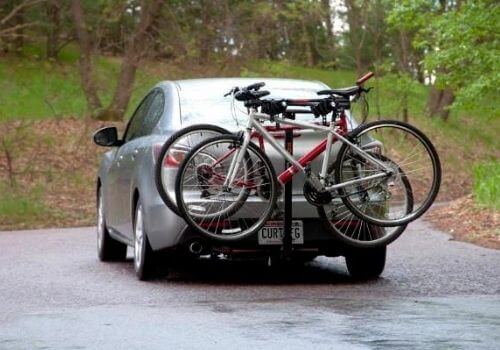
While they are both designed for lightweight towing, a class 2 hitch will be able to town up to 3,500lbs, which is substantially higher than the 2,000lbs that a class 1 hitch will cap out at.
Class 2 Hitches Explained
Class 2 hitches have been designed for cars that want to do a bit of lightweight towing, but perhaps something slightly heavier than a class 1 hitch.
Class 2 hitches will have a 1 1/4″ receiver size. The maximum weight that they will be able to pull will be at the 3,500lbs mark. Their tongue weight will be 350lbs.
- Receiver Size: 1-1/4″ x 1-1/4″ receiver
- Weight Rating: Up to 3,500 lbs. GTW
Class 2 vs Class 3 Hitch
Class 3 hitches are designed for heavier loads than class 2 hitches. A class 3 hitch will have a 2″ receiver in comparison to the 1 1/4″ receiver that you will find on a class 2 hitch.
You won’t really be able to hitch a class 3 hitch up to a car.
They are, instead, designed for SUVs, trucks, and other larger vehicles. They can tow up to 8,000lbs, which is over double what a Class 2 hitch is able to pull.
Class 3 Hitches Explained
Class 3 hitches are probably the most common hitches to be attached to SUVs and trucks. This is because they are exceedingly versatile.
They are able to pull up to 8,000lbs. The maximum tongue weight for a Class 3 hitch is a whopping 800lbs.
This means that they are going to be suitable for most recreational purposes outside of pulling the heaviest RVs and campers. These use a 2″ receiver which makes them versatile for just about most accessories.
- Receiver Size: 2″ x 2″ receiver
- Weight Rating: Up to 8,000 lbs. GTW
Class 3 vs Class 4 Hitch
Class 4 hitches are substantially larger than Class 3 hitches, although they are not as commonly used. While a Class 3 hitch can hold up to 8,000lbs, a Class 4 hitch will go up to 10,000lbs.
A class 4 hitch will also have a maximum tongue weight limit of 1,000lbs in comparison to the Class 3’s 800lbs. They both have the same receiver size, though. This is 2″.
Class 4 Hitches Explained
Class 4 hitches are used with trucks and SUVs. They cannot be used with crossover vehicles. They have a 2″ receiver, which means that they are going to be suitable for the vast majority of jobs.
The maximum amount of weight that they can pull is 10,000lbs with a tongue weight of 1,000lbs. They are more suited to commercial use than recreational towing.
- Receiver Size: 2″ x 2″ receiver
- Weight Rating: Up to 10,000 lbs. GTW
Class 4 vs Class 5 Hitch
There are a lot more different Class 5 hitches out there than Class 4. In fact, there are three different types of Class 5 hitch.
They have a maximum towing capacity of 20,000lbs. The hitch receiver will be either 2″ or 2 1/2″, depending on the hitch that is purchased.
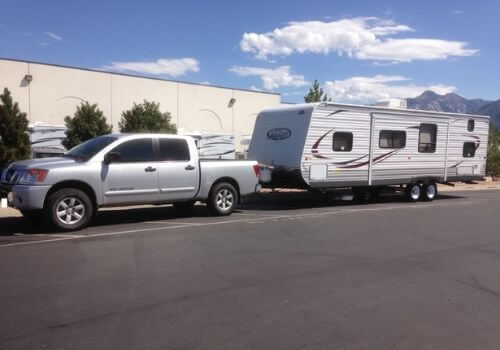
This is a difference to Class 4 hitches which only have a 2″ receiver. A class 5 hitch has about double the towing capacity of a Class 4 hitch.
Class 5 Hitches Explained
There are two main types of Class 5 hitch available. You have Xtra Duty or Commercial Duty. The former is more for recreational use, while the latter is, as the name suggests, for commercial use.
- Receiver Size: 2″ or 2-1/2″ receiver
- Weight Rating: Up to 20,000 lbs. GTW
Class 5 Xtra Duty hitch receivers are 2″ in size. They have a maximum towing limit of 18,000lbs with a tongue limit of 2,400lbs.
Class 5 Commercial hitch receivers are 2 1/2″ in size. They can tow up to 20,000lbs with a maximum tongue weight of 2,700lbs.
Read also: Trailer Hitch Installation How-To-Guide // 9 Easy Steps (Explained)
What Are the Different Trailer Hitch Receiver Sizes?
So, what Are the Different Trailer Hitch Receiver Sizes? There are 4 different trailer hitch receiver sizes out there which include:
• 1 1/4″
• 2″
• 2 1/2″
• 3”
The most common hitch receiver size will be 2″. This is going to be just large enough for most towing needs.
If you go down to 1 1/4″, then you are going to be ending up with something that is far too light in weight for the majority of jobs.
It is important that you know what your trailer hitch receiver size is. This is because it is going to be playing an important role in the accessories that it can accept.
It will also play a huge role in the amount of weight that you are going to be able to take on your trailer hitch.
So, of course, you do not want to get something that is too small for the job that you have because it means that you won’t be able to tow it.
What Are the Trailer Hitch Class Ratings?
Some trailer hitches have class ratings.
The purpose of the class rating is for people to instantly get an idea of a few pieces of information:
• Maximum weight capacity of the trailer hitch
• Maximum tongue capacity of the trailer hitch
• Size of the trailer hitch
There are five different hitch class ratings. Well, technically, there are 7. However, there are three different variants of the Class 5 hitch.
Remember, a trailer hitch class rating will only ever give you a rough idea of what you are going to be able to tow with the hitch.
You do need to read through the specifications for the actual hitch to know exactly what that brand and model is capable of.
Trailer Hitch Types and Ratings
The table below shows the trailer hitch types and ratings:
| Hitch Class | Applications | TW Capacity (lbs.) |
|---|---|---|
| Class 1 | Cras, crossovers | Up to 200 |
| Class 2 | Cras, crossovers, minivans | Up to 350 |
| Class 3 | Crossovers, vans, SUVs and trucks | Up to 800 |
| Class 4 | Trucks and SUVs | 1,000 |
| Class 5 – XD | Trucks and SUVs | 2,400 to 2,550 |
Trailer Hitch Compatibility Chart
The chart below shows the trailer hitch compatibility:
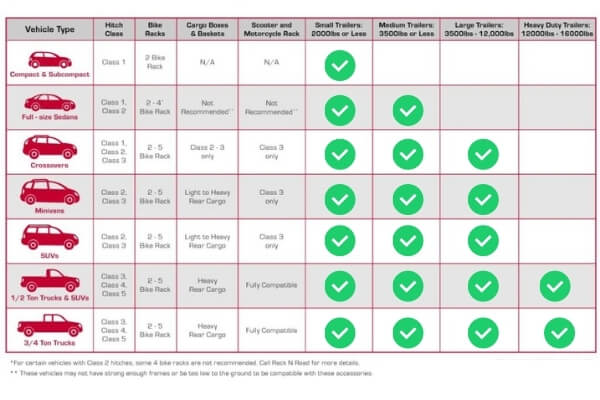
6 Different Types of Hitch Receivers
There are 6 different types of hitch receivers that can be installed on a vehicle which include:
- Custom hitch
- Rear mount hitch
- Front hitch
- Multi-Fit Hitch
- Bumper hitch
- RV hitch
Custom Hitch
A custom hitch is a hitch receiver that has been designed especially for your vehicle’s model. This means that it will often play the strength of your vehicle.
All of the fitting holes should be in the right place too, which makes it easier to connect up to your vehicle.
Custom hitches tend to only be available for the more popular trucks on the market.
Rear Mount Hitch
A rear mount hitch will attach to the underside of the back of the vehicle. This is probably one of the most common types of hitch that you can buy.
They will be available as both a custom hitch receiver and a multi-fit hitch receiver.
Front Hitch
Front hitches, as the name suggests, will be connecting up to the front of the vehicle. They are not going to be used for towing.
Most people will be suing these hitch receivers for winches, snowplows, and holding tires.
Multi-Fit Hitch
Multi-fit hitches are used when you are not able to get your hands on a custom hitch receiver. They have an adjustable frame on them.
The idea is that you can adjust the frame to get the exact right size for your vehicle. They are often going to be used on trucks and SUVs.
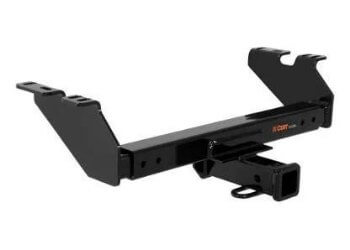
Bumper Hitch
Bumper hitch receivers are designed for lightweight towing, mostly with cars. They will fit to the bumper of the vehicle.
This means that the towing capacity is going to be quite low. However, they are some of the cheapest hitch receivers that you can buy.
RV Hitch
RV hitch receivers will typically be rather hefty hitch receivers designed to be able to take the substantial weight of an RV.
They will often be able to accept a variety of RV-specific hitch accessories. You will only really be able to attach these to trucks or larger vans. They cannot be connected up to cars.
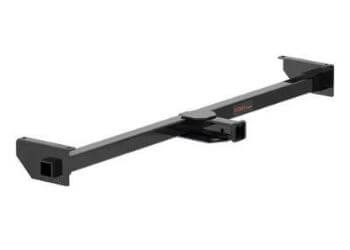
Heavy-Duty Tow Hitch Types
5th Wheel Hitch
If you are into your RVs, then 5th Wheel Hitches will be the hitch type that you will encounter the most.
This hitch type has a locking mechanism in place to hold the 5th Wheel Pin on the RV in nice and tight.
The hitch will also be able to move slightly to ensure that you have full control over the trailer while driving.
Gooseneck Hitch
Gooseneck hitches, unlike other hitches, will sit flat on the truck bed.
These types of hitches will most often be used to tow commercial items such as farming equipment, livestock trailers, etc. Unlike 5th Wheel Hitches, they do not have any movement in them.
They are pretty much your typical ball hitch, just a slightly different design.
Differences Between 5th Wheel and Gooseneck Hitches
Both 5th Wheel and Gooseneck Hitches have a maximum weight capacity of 30,000lbs.
One oif the main reasons people opt for gooseneck hitches is that they are simple to install. Sure, you are going to need to drill into the truck bed to install one.
However, once it is in place, it is going to be completely out of your way. They are dead simple to use too. It is nothing more than a ball hitch, after all.
The downside of Gooseneck Hitches is that they do not provide the smoothest towing experience when installed. They can also be dreadfully noisy. A lot of equipment also doesn’t use Gooseneck Hitches.
As we said before, these are often going to be used for towing farm machinery and other agricultural uses. While you can convert them to a 5th Wheel Hitch, it is a bit difficult.
5th Wheel Hitches are for those that are looking to tow the vast majority of recreational vehicles e.g. RVS, heavier trailers, etc. They have a lot of movement in them.
This helps to provide a smoother driving experience as the trailer should be able to move with the vehicle. They are pretty quiet too. Well, at least in comparison to Gooseneck Hitches.
The downside to these hitches is that they are quite expensive to buy. They also require a lot more effort to install them.
No matter what you do, once you have a 5th Wheel Hitch installed, you will have a rather hefty piece of equipment that is just going to be getting in your way too.
Different Types Of Trailer Hitches FAQs
Let’s close out this page about trailer hitch types and ratings with answers to some of your most frequently-asked questions about them!
How do I Know What Size Trailer Hitch I Need?
To determine what size trailer hitch you need, all you need to do is measure the internals of the tube. Measure from one side to the other. This will tell you the size hitch that you are able to slide into the hitch receiver. It should be pretty simple to do and you need nothing more than a tape measure.
It is likely going to be a 2″ hitch receiver, as this is the most common type of trailer hitch on the market.
Are Trailer Hitches Universal?
Are Trailer Hitches Universal? No, there isn’t a truly universal trailer hitch. Some companies, such as CURT, have designed trailer hitches to try and suit as many situations as possible.
However, even then, they are not going to be able to cover absolutely everything.
Which Hitches are Not Allowed?
Which Hitches are Not Allowed? No hitches are really banned. However, it is illegal to have more than one ball hitch on a vehicle. This is because more than one ball hitch has the potential to obstruct the license plate which, of course, is going to be a crime.
What Size is a Standard Hitch Receiver?
What Size is a Standard Hitch Receiver? There is not really anything that is a true standard hitch receiver size. However, most hitch receivers should have a 2″ ball on them.
What is the Difference Between a Class 1 and Class 3 Trailer Hitch?
Class 1 hitches are the most basic hitches that you can buy. They have a 1 1/4″ hitch ball. They have a maximum tongue weight of 200lbs and a maximum tow weight of 2,000lbs. Class 3 hitches, on the other hand, have a 2-inch ball.
They have a maximum tongue weight of 800lbs and tow weight limit of 8,000lbs.
What Size Trailer Hitch Does Uhaul Use?
What Size Trailer Hitch Does Uhaul Use? In most cases, you will need a hitch ball of 1 7/8″ or 2″. However, some of the trailers can differ. When you are renting the trailer, make sure that you talk to the staff.
They will be able to provide you with all of the advice that you need on ensuring that you choose the right trailer hitch for you.
What is the Best Trailer Hitch Receiver?
What is the Best Trailer Hitch Receiver? Some of the best-rated trailer hitches on the market will come from CURT. If you do buy a trailer hitch, then make sure that you read through the features and reviews to know that you are going to be getting the best hitch for you.
What Fits in a 5×8 Trailer?
What Fits in a 5×8 Trailer? A 5×8 trailer should be able to hold a Queen Size Bed plus a lot of extras.
Of course, the amount of weight that the trailer is capable of holding will be dependent on the trailer that you purchase, so make sure that you check the spec to know what you are getting.
For example, a U-Haul trailer of this size is rated to hold up to 1,800lbs.
What is a Hitch in Knots?
What is a Hitch in Knots? A hitch in knots has nothing to do with a trailer hitch, although it is likely how trailer hitches get their name. A hitch in knots is simply a way to tie a piece of rope to an object. There are a variety of different hitch knots.
Each of them is designed to ensure that the connection to the object is as tight as possible.
What is the Most Common Size Trailer Hitch Ball?
What is the Most Common Size Trailer Hitch Ball? The most common, by far, is a 2-inch hitch ball. So, if you have one of those installed on your vehicle, then you should be able to connect up most conventional trailers, boat trailers, etc. to your vehicle without any issues.
Will a Mechanic Install a Hitch?
Most mechanics should have absolutely no issues installing a hitch. It is going to be a pretty simple job for them, and they will love doing it.
Because of the simplicity of the job, it probably won’t cost you all that much in the way of cash to have it installed either.
Read also: Trailer Hitch Installation How-To-Guide // 9 Easy Steps (Explained)
Conclusion
So, there you have it. That is absolutely everything that you really need to know about trailer hitches. Well, at least in more general terms.
If you want to find out more about how your particular hitch or trailer works, then make sure that you consult the manual that came with it.
This should tell you absolutely everything that you need to know about the hitch.
References
https://www.uhaul.com/Articles/Tips/122/Trailer-User-Instructions/
https://www.curtmfg.com/5th-wheel/gooseneck-adapters/
Recent Posts
Trailer Hitch Installation How-To-Guide // 9 Easy Steps (Explained)
Have you ever wondered how to install a trailer hitch? Look no more. We´ve got you covered. Despite common belief, getting a trailer hitch installed isn't that difficult. in fact, chances are...
How Much Does It Cost to Install a Trailer Hitch? (with 9 examples)
The average cost to install a trailer hitch will vary between $250 and $750. Trailer hitch installation near me? Perhaps you’ve just bought a new trailer, or you’re a long-time tower that’s...

